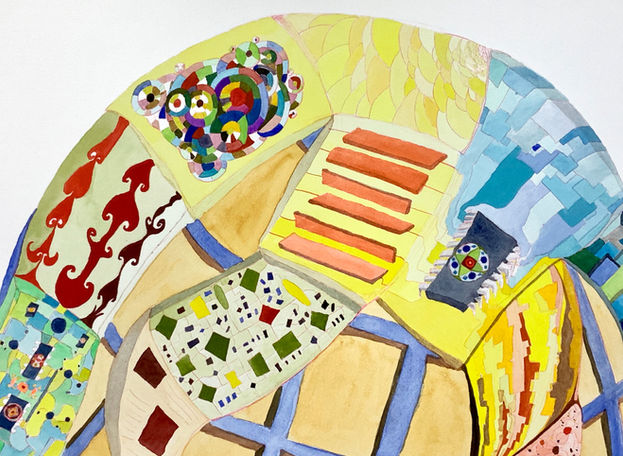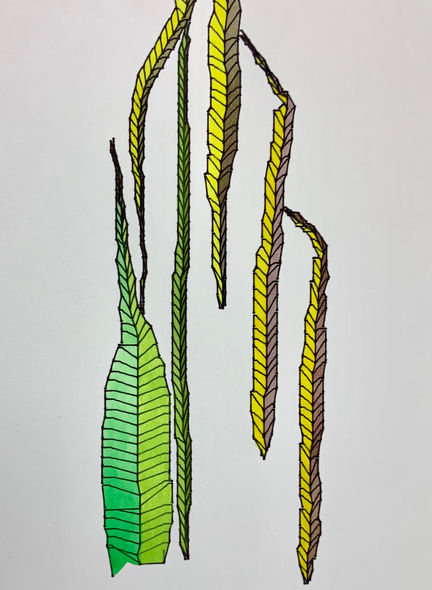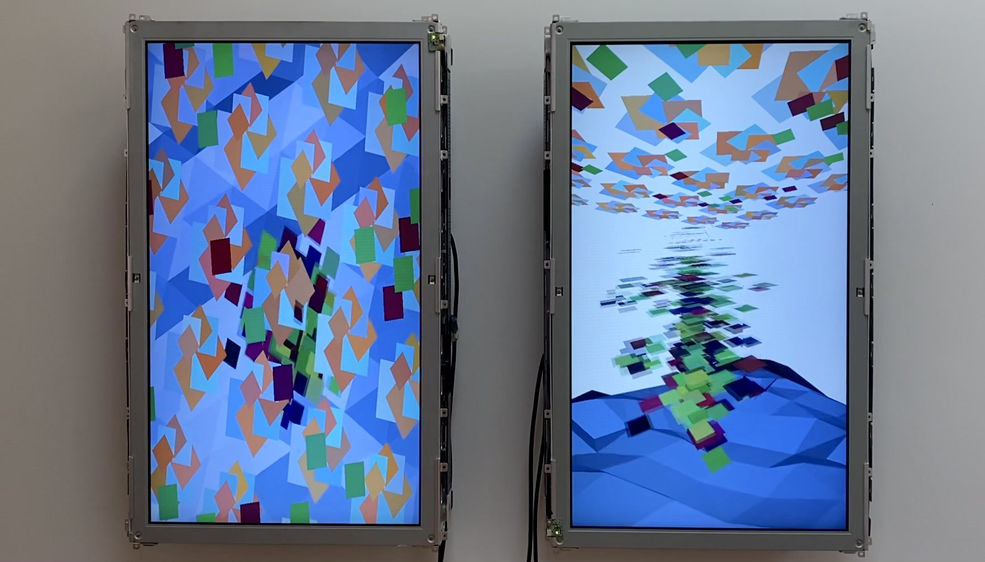
John F. Simon Jr.
Unfolding Moments
Nov 15th 2020 - Jan 15th 2021

Curator: Hua Zhao
Project Supervisor: Elaine Qiu
As a pioneer of software art, John F. Simon Jr. has explored new media art and challenged traditional notions of painting and drawing since the mid-1980s. Simon’s way of creating art is quite unique: he starts with drawings and makes the drawing process the object of meditation instead of identifying a subject beforehand. He revisits his improvisational drawings—which he calls “divination drawings”—and reworks these ideas, often by programming. Simon considers programming as a two-fold kind of creative writing, first in the sense of writing poems or stories but secondly recognizing that the computer screen is where the program creates images. In this way, Simon discovers a world full of surprises and novelty. The meanings of his artworks are open-ended and imbued with possibilities.
John F. Simon Jr.: Unfolding Moments | The Drawing Room
John F. Simon Jr. departs from the artistic tradition of creating one-of-a-kind images in favor of crafting one-of-a-kind computer programs, each of which quickly generates a wealth of images. Simon, who makes drawings on paper as well as computer-animated, wall-mounted panels and Web projects, draws inspiration from artists such as Paul Klee and Sol LeWitt, whose work alludes to or invokes rule-based, algorithm-like procedures. Simon is particularly interested in the way that the visual experiments of these artists can be automated and accelerated using digital technologies.
——“John F. Simon Jr. Unfolding Object,” Solomon R. Guggenheim Museum, New York
Simon explores different materials and textures in White Medusa and Red Medusa. The laser cutter makes it possible for Simon to create works of art that mirror each other but are distinct from each other. The name of Medusa not only recalls the vicious goddess but also indicates a type of computer cable sharing the same name. “Medusa” connects the mythical realm and the modern world, bridging gaps in historical times seamlessly.
Simon’s artworks deliver a sense of endless cycles. Contrasting scales in organic and hierarchical compositions acknowledge relativity. The vitality of life is embodied in Branching Growth and Emergence. Unfolding Planet conveys its richness by partially revealing what is within the planet. What is not presented to us keeps tantalizing us.
John F. Simon Jr., Earth Cycle, 2007.
Gouache on paper. 22 x 30 in.
John F. Simon Jr., Diurnal Cycle, 2007.
Gouache on paper. 22 x 30 in.
John F. Simon Jr., Phylogons, 2010.
Wall sculpture. Trupan ultralight, plastic laminate (Abet & Formica), flashe paint. 47 x 66 x 3/4 in.
Some of Simon’s works have a dreamlike quality — it is not to say they do not look real, but that they do not have direct references in reality and are real in a fantastical way. The otherworldly atmosphere derives from his process of creating art. Since 1999, every day, he clears his mind and meditates by drawing improvisational sketches on cards. He can shuffle and rearrange them in numerous ways as he likes. When he finds himself enchanted by particular shapes and forms, he turns them into larger works.
In Simon’s drawings, overlapped and interlocked structures appear on paper spontaneously. It is difficult to logicize their meanings, but they imply connection and rotation, evoking the alteration of day and night, seasons, and ceaseless changes. Simon embodies his contemplations on space and time in his representations of phylogons, a concept coined by Philip K. Dick’s novel The Divine Invasion (1981). Fascinated by the idea that by rearranging phylogons — general principle or archetypes — history can be manipulated, Simon wrote in his notes, “John suspected there had been a shift in the universe when moments in the day began to unfold like a flower blooming.”
John F. Simon Jr., Horizontal Study, 1994.
Pen plotter drawing, Rapidograph on paper. 22 x 30 in.
John F. Simon Jr., Family Tree, 1994.
Pen plotter drawing, Rapidograph ink on paper. 22 x 30 in.
John F. Simon Jr., Mother and Child, 2009.
Gouache and plastic laminate on paper. 30 x 22 in.
John F. Simon Jr., Plant Parts, 2009.
Gouache and ink on paper. 30 x 22 in.
John F. Simon Jr., Blue Balance, 1997.
Pen plotter drawing, Rapidograph ink on paper. 22 x 30 in.
John F. Simon Jr., Red Balance, 1997.
Pen plotter drawing, Rapidograph ink on paper. 22 x 30 in.
A whole different world unfolds when drawing does not mean drawing from life. To draw by pen plotter and other machines, lines and shapes have to be transferred into binary code, the language that the computer reads. “The computer does not look out at the world and draw plants and trees; the computer looks internally at its numbers and registers.” Liberated from imitation and representation, every moment of leaving the first mark on paper is indeed a “cosmogenic moment” (Paul Klee).
John F. Simon Jr., Every Thought, 2014.
Wall sculpture. HDU, trupan, abet laminate, acrylic paint, charcoal, ink. 83 3/4 x 93 3/4 x 2 3/4 in.

John F. Simon Jr., Moment of Expansion, 2014.
HDU, Trupan, Flashe Paint, Charcoal, Metal and Plastic Laminate. 108 x 192 x 8 in.
The concept of the frame, no matter in the context of art or otherwise, is an essential part of Simon’s explorations. Going beyond the structure is to leap, to escape, and to transcend boundaries. It is a release, not only for what bursts out but also for the frame itself. Simultaneously, it indicates a comfort zone and the desire to return to the frame, to go back to a stage when there is no excess or overflow when there is a perfect balance.
John F. Simon Jr., Morada IV, 2008.
Software, Apple Mini, LCD screen, lacquered wood, paint, laser cut Formica. 36 x 30 x 6 in.
Runs continuously, never repeats.
Simon’s ever-changing, never-repeating wall installations are mesmerizing. It is both sublime and terrifying to know that programmed variations cannot be exhausted in our lifetimes. Every wall installation is a world that continuously unfolds in front of our eyes. Their infinite nature and endless renewal are a profound metaphor.
If Simon’s works have a narrative, it will not be a dramatic story with cause and effect, a beginning and an ending. His works present the potential of beings by rendering moments of them unfolding themselves. Simon begins his creations with meditation, and we find ourselves in accord with him somehow: we have to be open and introspective when we appreciate them.
In 2013 - 2015, Streaming Museum New York produced a documentary film revealing John F. Simon, Jr.'s unique creative process.
The film was shot in Simon's studio in Sugarloaf, New York, based on several visits of Nina Colosi (founder, Streaming Museum) and Xiaoying Juliette Yuan (founder, JY&A) for their research on Simon's production of his signature piece, The Moment of Expansion (2014, included in the current exhibition). To this day, The Moment of Expansion remains one of Simon's most important also most complex works of his creative career.
A film by Streaming Museum by Nina Colosi & David Bates Jr. Copyright Streaming Museum, New York
John F. Simon Jr. was born in Shreveport, Louisiana in 1963, currently lives and works in New York.
As the pioneer of computer art in the US, Simon uses programming language as an activated extension of written language. He has investigated this principle in mediums as diverse as plotter drawings, acrylic sculptures, and online projects visible at his web site, www.numeral.com. His software programs displayed on wall-mounted screens, for example, feature unpredictable patterns of color and movement.
His works can be found in prominent museum collections such as the Museum of Modern Art (New York), Solomon R. Guggenheim Museum (New York), Whitney Museum of American Art (New York), Brooklyn Museum (New York), Phillips Collection (Washington, DC), San Francisco Museum of Modern Art (California), and Los Angeles County Museum of Art (California).
Special thanks to Sandra Gering, Laura Bloom (Sandra Gering Inc.), Melissa Shaw-Smith, and Nina Colosi (Streaming Museum New York), who had the generosity to share their precious visual materials to make this exhibition happen.
John F. Simon Jr:
Drawings
Every Moment is An Opportunity to Return to the Center (2013), Slide 2, 3
Every Thought (2014), Slide 2, 3
Swarms (2002), Slide 7
Fountain (2004), Slide 7
Morada IV (2008), Slide 9-11
Sandra Gering Inc.:
Every Moment is An Opportunity to Return to the Center (2013), Slide 1
Every Thought (2014), Slide 1, 4, 5
Moment of Expansion (2014), Slide 1, 2
Swarms (2002), Slide 1-6
Fountain (2004), Slide 1-6
Morada IV (2008), Slide 1-8
Melissa Shaw-Smith:
Cover photo
Moment of Expansion (2014), Stripe, Slide 3
Streaming Museum:
A studio visit with John F. Simon, Jr. in Sugarloaf, New York (2015)
























































































